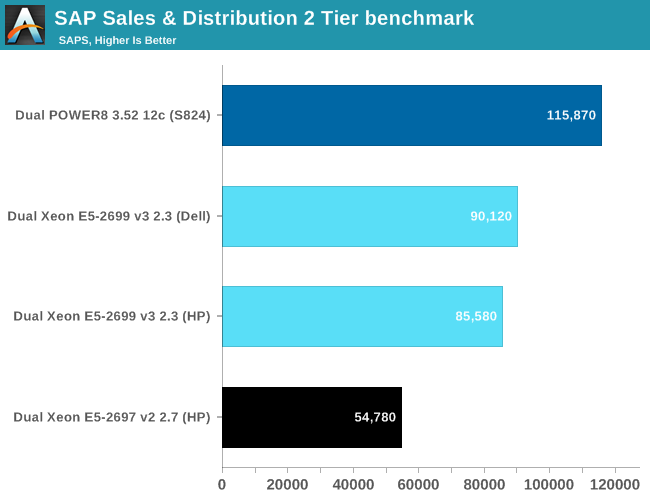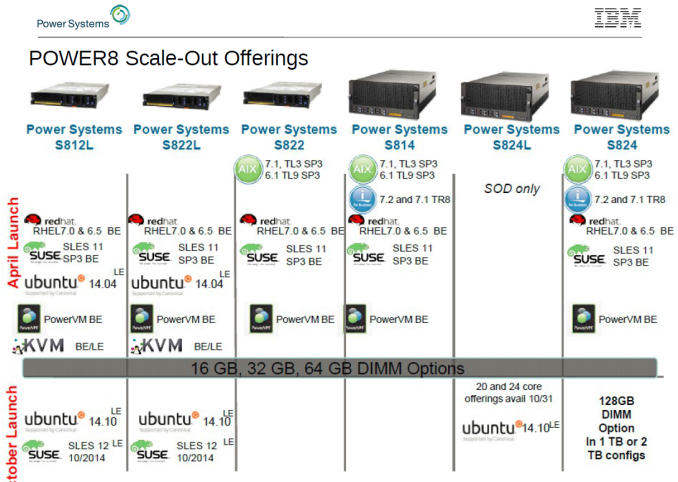The IBM POWER8 Review: Challenging the Intel Xeon
by Johan De Gelas on November 6, 2015 8:00 AM EST- Posted in
- IT Computing
- CPUs
- Enterprise
- Enterprise CPUs
- IBM
- POWER
- POWER8
Reading the Benchmarks
There are a lot of benchmarks available that compare the IBM POWER8 to Xeons. One example is the Enterprise Resource Planning (ERP) software SAP. We have used the Sales & Distribution 2 Tier benchmark many times because it is one of the very few benchmarks that is a very good representation of real world high-end enterprise workloads.

Now combine this with the benchmarks that IBM has compiled on their marketing slides and the fact that we know that the POWER8 chip has a TDP of 190W at nominal speed and 247W when running at "Turbo" clockspeeds.
It all seems very simple: the IBM POWER8 is a more power hungry chip but delivers much better performance. But as always you should take the time to read the benchmarks very closely. The IBM S824 is typically the one featured in the benchmarks. However, we are pretty sure that is not the system that will be able to sway the current Intel Xeon customers towards OpenPOWER. Nor are we convinced that the most widely reported benchmarks are accurately predicting the experience of those people.
There are three reasons for that. First of all, most of the benchmarks are run on AIX (7), IBM's own proprietary UNIX. AIX is a high performance, extremely robust OS, but it does not have the rich software system and support that Linux has. Furthermore even with their common design elements, an excellent Linux administrator will have to invest some time to get the same level of expertise in AIX. But more importantly, the S824 is a pretty expensive machine, both in acquisition cost (starting at $21.000, up to $60.000 and more) and energy cost. That kind of pricing lands the system in hostile and more powerful quad Xeon E7 territory.
Lastly, the S824 uses two CPU cards or Dual Chip Modules (DCM), each containing two six-core POWER8 modules at 3.5 GHz. Now consider that the third party OpenPOWER servers have 190/247W TDP 10-core 3.4 GHz POWER8 CPUs. The power consumption does not increase linearly as you add more cores and higher clocks. So the CPU modules found inside the S824 are definitely more power hungry, probably well above 250W.
There is more. Take a look at IBM "Scale-out" server, the more affordable server range of IBM servers. First, a bit of IBM server nomenclature which is actually quite logical and easy to decipher (take note, Intel marketing).
- S stands for "Scale-out"
- 8 stands for POWER8
- 1 or 2 is the number of sockets
- 2 or 4 is the height, expressed in rack Us.
So an S824 contains 2 sockets in a 4U chassis and a S812 is a one socket system. There is one designation left, : the "L" or Linux .
Notice that the non-L versions also support Linux, but a few months ago they supported only the Big Endian (BE) versions (the slide is from the beginning of this year). IBM told us that all POWER8 servers now support both Little Endian (LE) and BE Linux.
This is important since using an LE version (Ubuntu, SUSE) makes data migration from and data sharing (NAS, SAN) with an x86 system much easier, as x86 only supports LE.












146 Comments
View All Comments
jesperfrimann - Monday, November 9, 2015 - link
Well, I think you should kick Franz Bourlet, for not hooking you up with with a IBM technical Advocate who actually knew the technology. Such a person could have shown you the robes and helped you understand the kit better. Again Franz is a sales guy.IMHO selecting Ubuntu as the Linux distro, did not help you. It's new to the POWER platform and does not have the same robustness as for example SLES which have been around for 10+ years on POWER.
The fact that you are getting better results using gcc generated code rather than xLC, shows me that something is not right.
And that the IBM JDK isn't working is well also an indicator that something is now right.
IMHO selecting Ubuntu, did not make Things easier for you Guys.
And for really optimized code you need to install and use High performance math libraries for POWER (MASS), which is an addon math library.
And AFAIR having 8 memory modules, only enables half the memory bandwidth of the system.
So IMHO IBM didn't help you make their system look good.
But again that is what you get when you get rid of all the clever people :)
// Jesper
nils_ - Wednesday, November 11, 2015 - link
You can always rent a box at OVH, they offer a huge chunk of an OpenPower System, albeit virtualized through Runlabs.stefstef - Sunday, November 8, 2015 - link
compared to the pentium 4 the mips r16k with loads of l3 cache was a bzip2 beast, outperforming the pentium 4 which ran at twice the clock speed and more. despite that the usage of zip programs is what these server processors are build.mapesdhs - Tuesday, November 10, 2015 - link
Just curious, do you know of any comparative results anywhere for bzip2 on old MIPS vs. other CPUs? It's not something I've seen mentioned before, at least not with respect to SGIs, but perhaps I can run som tests the next time I obtain a quad-R16K/1GHz (16MB L2) Tezro. Best I have at is only an R16K/900MHz (8MB L2) single-CPU Fuel and various configs of Tezro and Onyx350 from 4 to 16x 700MHz with 8MB L2. Just a pity SGI never got to employ multi-core MIPS (it was planned, but alas never happened).Oddly, back when current, MIPS' real strength was fp. Over time it fell behind badly for general int, though for SGI's core markets that didn't really matter ("It's the bandwidth, stupid!" - famous quote from Mashey IIRC). MIPS could have caught up with MDMX and MIPS V ISA, especially with the initially intended merged Cray vector stuff, but again that all fell away once the design talent moved to Intel in 1996/7.
Ian.
Freen the merciless - Sunday, November 8, 2015 - link
Heh! Sparc T5 eats Xeon and power for breakfast.kgardas - Monday, November 9, 2015 - link
I guess you mean T7 with SPARC M7 inside and not T5. If so, then yes, M7 looks quite capable, but unfortunately provides horrible price/performance ratio. POWER8 box starts at ~6.5k $ while T7-1 on ~40k $. So on SPARC front we'll need to see if Oracle is going to change that with Sonoma chip.Michael Bay - Monday, November 9, 2015 - link
In parallel only.aryonoco - Tuesday, November 10, 2015 - link
Thank you Johan for this amazingly well written and well researched article.I have to agree with a few people here that question your choice of using LE Ubuntu to test. Traditionally people who use Linux on POWER use SUSE, and some use RHEL, but Ubuntu? Nothing against them, and I love apt, but it's just not a mature platform.
Try with something more representative such as BE SLES and you will find a vastly different types ecosystem maturity.
But thanks again, and also thanks to AT for caring about such subjects and publishing these tests.
JohanAnandtech - Wednesday, November 11, 2015 - link
Thank you for taking the time to write up some constructive feedback. I have years of experience with ubuntu and linux and I wanted to play it safe. Running benchmarks on "new" hardware with a new ISA (from my perspective) is pretty complex. C-ray and 7-zip are the only exceptions, but most real server apps (NAMD, ElasticSearch, Spark) depends on many layers of software.In theory the OS/ distro is more important to get applications working than the ISA. In practice, it might have been better to bet on the distro with the most maturity and adapt our scripts and installation procedures to Suse.
But as soon as I get the chance, I'll try out BE suse or redhat on a POWER system.
mapesdhs - Tuesday, November 10, 2015 - link
Johan,A minor point, please note my home page for C-ray is here:
http://www.sgidepot.co.uk/c-ray.html
Blinkenlights is just a mirror, and not the primary mirror either (that would be the vintagecomputers site).
Btw, it's a pity you didn't use the same image sizes & settings as used on the main c-ray site, because then I could have included the results on my page (ie. 'sphfract' at 800x600, 1024x768 with 8X oversampling, and 7500x3500), or did you just use the same settings that Phoronix employs?
Also, John Tsiombikas, the guy who wrote C-ray, told me some interesting things about the test and how it works (info included on the page), most especially that it is highly vulnerable to compiler optimisations which can produce results that are even less realistic than real life workloads. I'm glad thought that you did at least use the sphfract test, since at a sensible resolution or with oversampling it easily pushes the test out of just L1 (the 'scene' test is much smaller). But yeah, overall, c-ray was never intended to be used as a benchmark, it's just taken off somehow, perhaps because the scanline method of threading makes it scale very well.
Hmm, I really must sort out the page formatting one of these days, and move the most complex test tables to the top. Never seem to find the time...
Thanks!!
Ian.
PS. I always obtained the best results by having more threads than the no. of cores/CPUs, or is this something which doesn't work with non-MIPS systems?